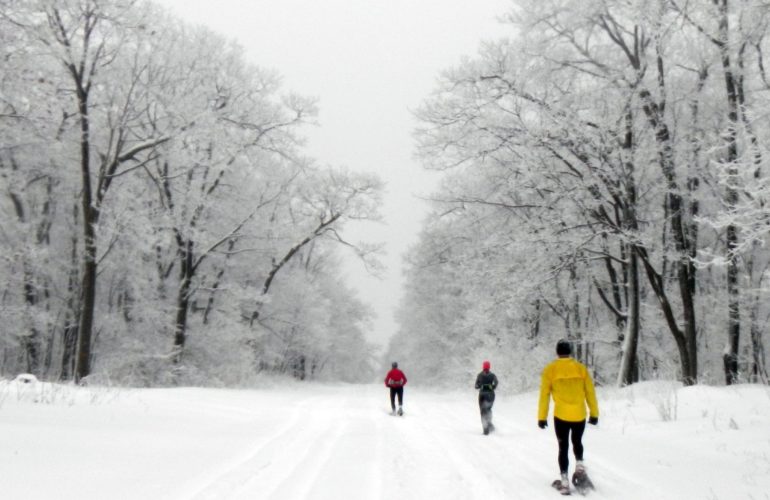
Few things match the beauty and isolation of hiking or trail running in the winter. Green landscapes dotted by bright-colored trees give way to snow-covered, wind-swept lands that appear desolate but are teeming with life.
But with its beauty, winter brings challenges that must be addressed before heading outside. Here’s a breakdown of the steps you need to take to ensure you come home from a cold hike outside.
Dress in layers
Sweating on the trail is an inevitability. And while that may not be a big problem in other seasons, it’s a big problem in the winter. That’s because sweating + cold = hypothermia. To prevent hypothermia, it’s advised you dress in layers.
Proper layering consists of a base layer, midlayer and an outer layer. For a base layer, choose a wool or synthetic shirt. The old saying “cotton kills” comes from the materials’ inability to dry quickly and wick sweat. Hypothermia occurs when you lose body heat faster than you create it.
For a midlayer, choose a wool/fleece sweater or down jacket. For the outer layer, choose a waterproof and breathable jacket. Nylon or polyester are good options. A breathable and moisture wicking pair of gloves and a hat to protect yourself from the cold wind are also critical.
When you begin feeling warm or start sweating, open your jacket to get some airflow. You don’t want your layers wet, either from sweat or snow.
The National Park Service says that early symptoms of hypothermia include slurred speech, trembling, exhaustion, stumbling, and impaired judgment. Unchecked, symptoms may progress to mental confusion, unconsciousness, and eventually death.
Choose proper footwear
Having the right footwear is one of the most important items to check off on your list before heading out in cold weather. You’ll want to wear Merino wool socks beneath whatever footwear you choose. That’s because Merino wool is lightweight, breathable, and doesn’t smell. And while paying $25 for a single pair of socks sounds crazy to new hikers or trail runners, it will pay off in the long run. Also, many companies offer lifetime guarantees making it a sound investment.
If there’s snow on the ground or you expect muddy conditions, make sure to bring waterproof boots or shoes. And make sure you try on your footwear WITH your wool socks to make sure they fit. Wet feet lead to all sorts of injuries that you don’t want.
Plan your trip and tell someone
The stakes are always raised when you go for a run or hike in the winter. Not only is the weather more unforgiving, but there are less people on trails to rely on for help.
Make sure you plan your trip before leaving the house. Don’t expect printed trail guides to be available. Download the map on your phone, find your trail, determine its difficulty and elevation and be sure to follow trail blazes.
Lastly, make sure you tell a friend or family member where you are going and when you expect to be back. Set up a time you will contact them when you get home. That way, they know what time to expect you to be complete. If they don’t receive a call or text, they have an approximate location to send for help.
I have this exact system in place when my friend James goes trail running at night. He sends me his location, when he begins and lets me know when I should expect him back. Luckily, nothing has ever occurred to require me to call for help. But, if it should occur, we have a safety system in place.
Pack water and essentials
No matter the season, no matter the weather and no matter the distance, always pack plenty of water. Pack at least 32 ounces and remember to stay hydrated. In the cold, it may not feel like you need to drink water, but be sure that you do.
When it comes to the rest of your kit, you can pack as much or as little as you like. My hiking pack includes a first aid kit, fire making kit, Mylar blanket, multi-tool, water filtration, headlight with extra batteries, power bank and snacks. I take that kit (which includes a couple other items) whenever I hike, whether it be on a trail I’ve been a million times or a new one.
There are some amazing YouTube videos to find out what you may want to keep in your kit.
Keeping those things in mind, be sure to take some time to experience the outdoors in the winter. There are some amazing sights and sounds to experience in a landscape void of human beings but filled with life.
I hope to see you out on the trails!
For a healthy, happy you in 2022, add the goal of spending more time outdoors to your list of new year’s resolutions! For a little inspiration, learn about the many benefits of outdoor recreation, no matter the season, in PPFF’s recent video, “Health Benefits of Outdoor Recreation”.

Christian Alexandersen ran one mile in each of Pennsylvania’s 121 state parks in 2021 and has been sharing with us stories and tips from his journey. To read more blog posts from Christian and other PPFF guest bloggers, visit our News page.
Subscribe to our weekly e-blast to stay up to date on News, Events, and Blog posts!




